 Artwork by Rose L. (Grade 2, Virginia).
And we're back!
It’s been a busy summer here at the NOAA Marine Debris Program. We were fortunate enough to present at three educator conferences! Thank you to all of the wonderful educators around the country who attended the National Marine Educators Association Virtual Conference, the Virginia Association of Environmental Education Summer Conference, or the Northwest Aquatic and Marine Educators’ Conference. It was a pleasure to engage with all of you and share some of our resources to help support you and your work, and we're looking forward to connecting with you at future conferences.
But that’s not all! This summer we also celebrated Ocean Month. To relive all the excitement, dive into the National Ocean Service’s content on the ocean’s importance to health and safety, the economy, and marine life.
Looking ahead, we’re excited to support those of you returning to school and school-year programming. Check out some of our back-to-school resources:
-
Locations and Languages: Marine Debris Curricula and Resources from Near and Far: As students and teachers prepare for a new year of learning, we are sharing educational marine debris resources that highlight the problem in different locations and different languages.
-
Back to School Special: What are you going to throw away this school year? The new school year can be a new beginning, so why not take this time to build some better habits in the classroom? Figure out how much waste your class creates through a trash audit!
-
Keeping Lunches Debris-Free: As you prepare for the new school year, take a moment to consider your lunch choices, including the items you pack in your lunches or choose to purchase in a cafeteria. With just a few simple changes, you can prevent your lunch waste from becoming marine debris. (For more tips and tricks, check out our featured crafts at the bottom of this newsletter!)
Enthusiastically,
Alexandria Brake, Education Specialist
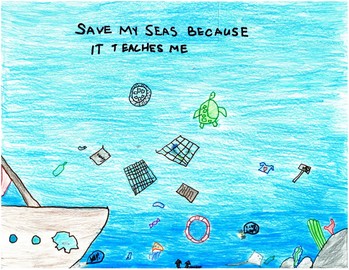 Artwork by Kelsen S. (Grade 3, Hawaii).
The first step to solving a problem is learning more about it. NOAA’s Marine Debris Program is here to help you learn more about the problem of marine debris! To support that mission, we have created an easy-to-use platform through which to access all of our educational materials. Our new education section has organized resources to support stewards from any audience, including educators looking for lesson plans, students researching projects, families hoping to make a difference, professionals catching up on the latest science and policy, and anyone in between.
Learn more
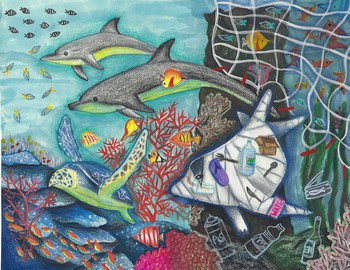 Artwork by Jeewoo S. (Grade 8, Commonwealth of the Northern Mariana Islands).
Congratulations to the winners of this the 2021 NOAA Marine Debris Program Art Contest! This year’s art contest has been unlike any other, and it was made possible by the many adaptations of our young artists and staff. We received many colorful, fun, and informative entries from around the country, and although we wish we could showcase them all, we are excited to share the winners of this year’s contest with you.
Learn more
The "Did You Know?" marine debris bookmark series is full of vibrant and colorful images with fun facts about marine debris (Credit: NOAA).
June was Ocean Month, and we ended the month of celebration by exploring some Ocean Trivia. Check out these activities, lessons, and resources that use curiosity and inquiry to answer your questions about marine debris.
Learn more
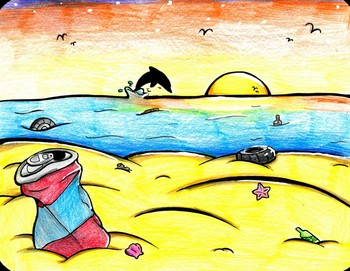 Artwork by Nadia B. (Grade 8, Maryland).
Curious where marine debris can take your students in a future career? Check out this feature from the Office of Response and Restoration on one of the NOAA Marine Debris Program’s amazing research analysts, Carlie Herring! Read all about her journey of curiosity and passion from exploring tide pools, through her “dolphin phase,” all the way to a career in marine debris research.
Learn more
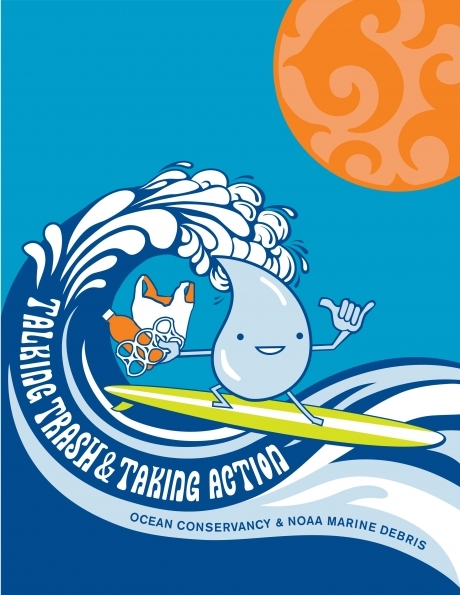 Talking Trash & Taking Action will guide your class through a series of fun, engaging activities to support a scientific cleanup effort (Photo: NOAA).
Get your learners ready for the International Coastal Cleanup this September with this engaging and fun cleanup curriculum from the NOAA Marine Debris Program and the Ocean Conservancy. With introductory lessons on marine debris composition, currents and gyres, and impacts on marine life (just to name a few) and robust guidelines for planning cleanup activities as a class community, this unit will help set up a safe, scientific, and successful cleanup effort.
Learn more
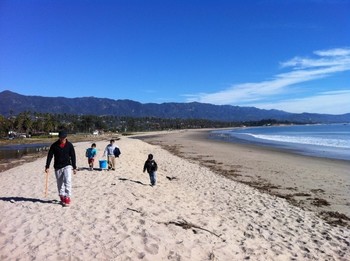 We can all play a part in preventing marine debris across the country (Photo: NOAA).
NOAA Sea Grant and the NOAA Marine Debris Program announce the funding of six new, creative projects to tackle marine debris challenges across the country. This year’s projects focus on preventing the introduction of marine debris into marine, coastal and Great Lakes environments.
The six competitively selected projects cover the southeast Atlantic, Pacific, and Great Lakes waters, coming from Florida, Georgia, Hawai‘i, Illinois-Indiana, Puerto Rico, and Wisconsin Sea Grant programs. Project activities include incorporating data of marine debris items removed from marinas into outreach and education materials, repurposing shrimp trawl nets into marine debris collection bags, developing a coordinated marine debris messaging campaign for the Great Lakes region, creating comprehensive curricula related to marine debris prevention, outreach to prevent recreational fishing debris, and using storytelling to inspire new audiences.
Learn more
 "Hooray! Back to school!" Be as excited as these two Laysan albatrosses with NOAA's back to school resources (Photo: NOAA).
Support marine debris learning throughout the year with NOAA's Earth science content. Here are a few favorite education resources for teachers, and you can find even more in NOAA's resource collections.
- Teach about climate and climate change
- Be citizen scientists using only a smartphone or computer
- Discover brand new watershed education resources
- Connect with NOAA experts
Learn more
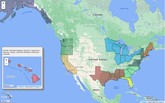 |
|
In this new section below, check out some features from our education projects around the country. |
 Follow along with the Turtle Trash Collectors Interactive Video with the Program Activities Guide (Photo: University of North Carolina Wilmington MarineQuest).
Turtle Trash Collectors is a University of North Carolina Wilmington MarineQuest environmental education initiative supported by the NOAA Marine Debris Program. The goal of this initiative is to educate youth about the impacts of marine debris and encourage behavior changes that reduce the generation of marine debris in the future. From 2019-2021, MarineQuest implemented the Turtle Trash Collectors program both in-person and virtually, reaching over 29,500 people worldwide.
Now their incredible virtual resources are available online! Watch the lesson in the Turtle Trash Collectors Interactive Program Video, and follow along with the Program Activities Guide. This hour-long program has modifications for younger and older students, who can virtually participate in a simulated sea turtle necropsy (or animal dissection) learn how trash can get to the ocean and impact sea turtles, and learn how we can all help stop marine debris!
Learn more
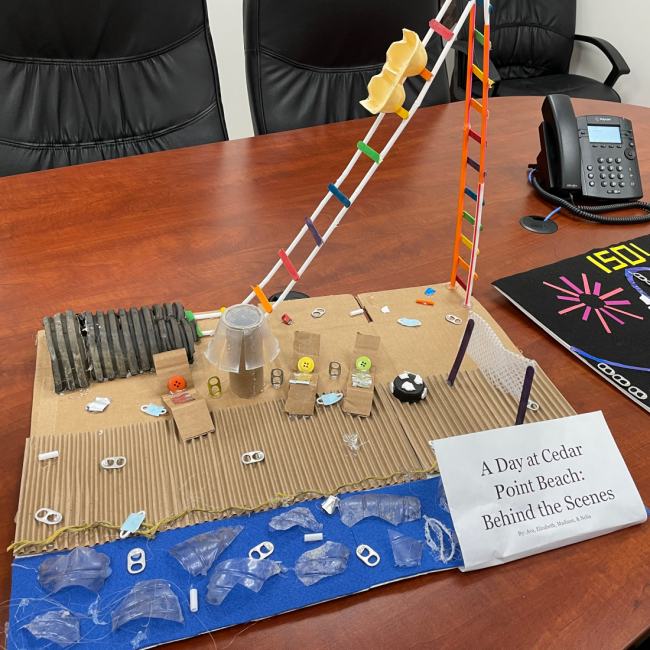 First place artwork by Ava L., Nelia N., Madison S., and Elizabeth Z. (Photo: NOAA).
The NOAA Marine Debris Program is excited to announce the winners of the sixth annual Ohio Marine Debris Challenge! This year, middle and high school students from Ohio’s Lake Erie coastal communities completed lessons and created artwork to raise awareness about the global problem of marine debris, especially in the Great Lakes. Students were challenged to create original artwork using repurposed trash that showcased Cedar Point Amusement Park’s 150th Anniversary.
Learn more
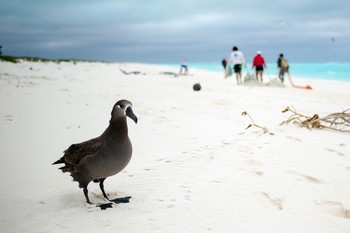 Derelict nets will be a primary focus of this year's Papahānaumokuākea Marine National Monument removal mission, and they pose a serious entanglement risk to many marine animals, including albatross like this one (Photo: NOAA).
The Papahānaumokuākea Marine National Monument (monument) is integral to Native Hawaiian culture and is a sacred landscape. Unfortunately, marine debris has and continues to pose a significant threat to its natural and cultural resources. We are pleased to support the NOAA Pacific Islands Fisheries Science Center’s Marine Debris Project team as they launch a 30-day mission in the monument with support from the non-profit Papahānaumokuākea Marine Debris Project.
To help bring this incredible mission to life in your classroom, check out Makani: The Albatross that Cares for the Land, Makani Ka Mōlī Mālama ‘Āina. This dual language workbook engages readers through the eyes of a Laysan Albatross named Makani. Learn about Hawaiian wildlife, culture, navigation, and natural resource management in both English and Hawaiian. This place-based workbook includes information on marine debris, a beach survey form, and a worksheet that compares modern objects with their sustainable, traditional Hawaiian counterparts.
Learn more about this year's mission.
Learn more about the decades-long history of marine debris removal in the monument.
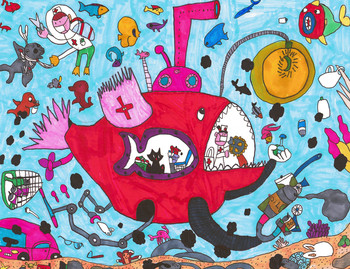 Artwork by Simone L. (Grade 1, Michigan).
From Hawai‘i to the Gulf of Maine, our many regional action planning partners are doing amazing work to support educational initiatives in their communities. So many, in fact, that we can't feature them all in this newsletter! Learn more about Hawai‘i STEM teacher workshops, Oregon remote-operated vehicle competitions, and lots of other incredible efforts across the country by subscribing to your region's action planning newsletter. Not only will it keep you in the loop on awesome projects, but it will also be a great opportunity to join in the process of creating regional action plans to support your students and communities in reducing marine debris.
Find your regional newsletter on the regional page, or reach out to your Regional Marine Debris Coordinator to learn more.
 Reusable utensils are one way to reduce waste during the school day (Photo: NOAA).
It might feel like you need to brace yourself for the slew of purchases (and waste) that can come along with heading back to school. From new pencils to new lunchboxes, the list just seems to get longer each year. Not to mention trying to keep up with the stacks of old summer-camp t-shirts in the closet! Fortunately, there are a few ways you can re-purpose those too-small t-shirts into sustainable items that keep the planet thriving. So grab your scissors and your old t-shirts and get ready to get back to school waste-free!
Shop Waste-Free with Reusable Bags
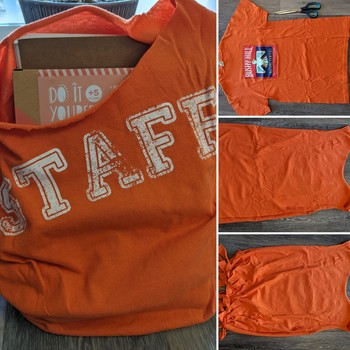 There are only a few steps between an old t-shirt and a reusable bag! Top-Right, Step 1: Lay out your shirt. Middle-Right, Step 2: Cut out the sleeves and collar. Bottom-Right, Step 3: Cut and tie fringe along bottom. Left, Step 4: Fill up your bag! (Photo: NOAA).
Supplies Needed:
Steps:
- Lay your t-shirt out flat.
- Cut off the sleeves and collar of the shirt, then turn it inside out.
- Cut a row of fringe along the bottom of the shirt, about the length and width of your finger.
- Tie the fringe in a criss-cross pattern: Tie the top-left piece of fringe to the bottom-right piece of fringe.
- Then tie the bottom-left fringe to the top-right fringe in the same criss-cross pattern. (A quick note: Be sure to tie these tightly! I did not, and was left with a few holes in the bottom of my bag.)
- Continue tying these criss-crosses all along the bottom of your bag.
- Tie another row of criss-crosses, this time connecting new sets of knots. This should help close any gaps in the bottom of your bag!
- Turn your bag right-side out and fill it up!
Looking for video directions? Check out this demonstration by Ocean Today host Symone Barkley with Black in Marine Science. (This video is not affiliated with NOAA and does not represent the opinions of NOAA, nor does this link imply that NOAA recommends or endorses those expressed by partner organizations.)
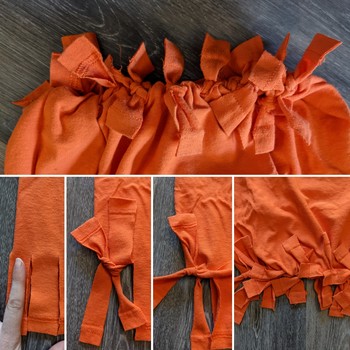 These knots will secure the bottom of your bag! Bottom, from left, Step 1: Cut fringe about the length/width of a finger. Step 2: Tie the top-left fringe to the bottom-right fringe. Step 3: Tie the bottom-left fringe to the top-right fringe. Step 4: Tie all across the bottom of your bag. Top, Step 5: Tie fringe ends again, creating another set of criss-cross knots to close any gaps (Photo: NOAA).
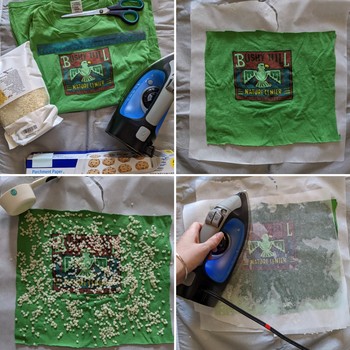 You don't need a whole colony to create your own beeswax wraps! The top-left image has all the supplies you'll need. In the top-right, we have step 1: Cut out your scrap and place it over parchment on your ironing board. Step 2 is on the bottom-left, cover your scrap with beeswax pellets. Finally, the bottom-right shows step 4, lay out another piece of parchment and iron your wrap (Photo: NOAA).
Supplies Needed:
- Clean t-shirt
- Scissors (Pinking shears or zig-zag scissors might work better to prevent fraying, but I don't own any to model.)
- Iron & ironing board
- Beeswax pellets (available at most craft stores or online)
- Ruler (optional)
Steps:
- Lay your t-shirt out flat, and cut out a 11x11-inch square. (Any size square will work, but these measurements are a good fit for most bowls or snack items.)
- Place your square of fabric over a piece of parchment paper on your ironing board.
- Scatter beeswax pellets across your fabric (1/3 cup should be enough for an 11x11 square).
- Place another piece of parchment over top of the beeswax. (This is important to protect your iron!)
- Iron out your fabric wrap, ensuring the wax melts evenly across the square. If you have globs of wax in some areas, place another piece of fabric over top to soak some up.
- Remove the parchment paper and hang up your wax wrap to dry.
- Say goodbye to your plastic wrap and enjoy your low-waste lunch!
Want to turn this into an engineering and design exercise? Check out this standards-aligned lesson plan from Hawaiʻi Sea Grant.
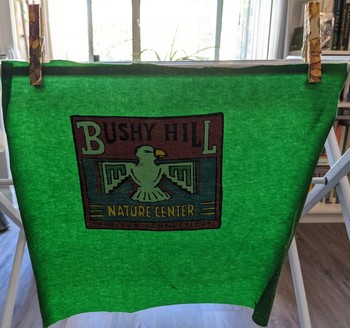 Hang up your finished beeswax wrap to cool and dry before using (Photo: NOAA).
Interested in more ways to help prevent marine debris at home, at school, or at the store? Dive into all kinds of ideas on our How to Help page.
Have any feedback on our content?
Please reach out and contact us if you have any questions, ideas, or hopes for our marine debris materials.
Contact us at marinedebris.web@noaa.gov
Subscribe to the NOAA Marine Debris Program Education Newsletter
Subscribe to the NOAA Marine Debris Program Monthly Newsletter
Subscribe to the Marine Debris Blog
|